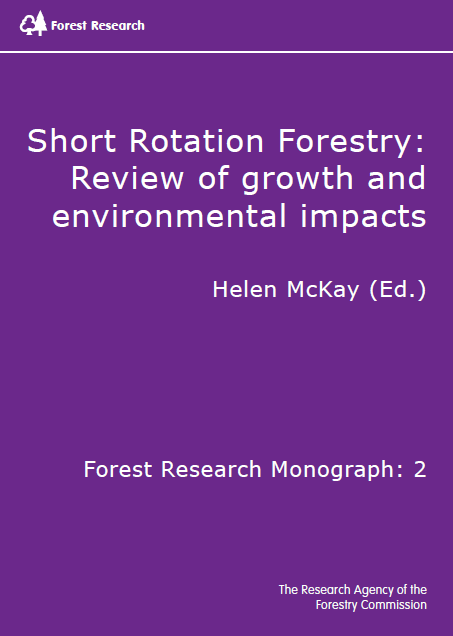This review draws on the expert judgement of many Forest Research scientists who were given a common brief to review: the growth, yield, and biomass distribution of the most promising species managed under short rotations; potential impacts on hydrology; aboveground biodiversity; the historic environment; soil and nutrient dynamics; and the potential impact of pathogens and pests on growth.
 Background
Background
The UK has a target for 15% of its energy consumption in 2020 to be from renewable sources. Under Article 4 of the European Renewable Energy Directive (2009/28/EC), each Member State had to submit a plan (National Renewable Action Plan) to reach this target. The UK’s lead scenario is that around 30% of electricity, 12% of heat, and 10% of transport energy come from renewable sources by 2020. While this does not represent fixed targets for particular sectors, it is anticipated that biomass will play a key part in delivering the overall target.
Delivering the European renewable energy target is expected to increase the demand for biomass feedstocks in the heat and power sectors. The analysis presented in the National Renewable Action Plan suggests that there could be sufficient biomass resource potential in the UK to meet this demand for heat and power in 2020, if the supply potential is fully developed. This assessment assumes that we could rapidly increase the production of energy crops in the UK, increase wood fuel supply from sustainable forestry, make better use of agricultural residues, and fully exploit waste biomass currently going to landfill.
It has been suggested that short rotation forestry (SRF), particularly using Eucalyptus, has the potential to deliver greater volumes of biomass from the same land area than alternative biomass crops. SRF is the practice of cultivating fast-growing trees that reach their economically optimum size between eight and 20 years old; each plant produces a single stem that is harvested at around 15 cm diameter. The crops tend to be grown on lower-grade agricultural land, previously forested land, or reclaimed land, and so do not directly compete with food crops for the most productive agricultural land. Experience of SRF in Britain is limited, creating a need to establish whether it is a viable renewable energy source.
In 2006, the influential Hardcastle review of the environmental impacts of growing fast-growing broadleaved species as SRF in Britain (Hardcastle 2006) recommended that a series of field trials was set up to further investigate impacts where relevant data were particularly sparse; corroborate conclusions where some data were available; and provide the foundation for assessments of growth and yield. Funding was made available in 2008 to establish the viability, feasibility, sustainability, and appropriateness of SRF as a renewable energy source in England; this review is one of seven contract deliverables.
Scope and rationale
This review updates the Hardcastle review and, where possible, strengthens it using primary unpublished data. It draws on the expert judgement of many Forest Research scientists who were given a common brief to review:
- the growth, yield, and biomass distribution of the most promising species managed under short rotations
- potential impacts – both positive and negative – of SRF on hydrology; aboveground biodiversity; the historic environment; soil and nutrient dynamics
- the potential impact of pathogens and pests – both insects and mammals – on growth.
The species covered are those being considered for the complementary field trials: ash, hybrid aspen, red alder, Italian alder, sycamore, silver birch, sweet chestnut, shining gum (Eucalyptus nitens), Tingiringy gum (E. glaucescens), cider gum (E. gunnii), and rauli (Nothofagus alpina, syn. N. procera). Authors were directed to concentrate on the species creating most concern among environmental NGOs and the general public, i.e. the eucalypts, with less intensive effort devoted to the native/naturalised species (ash, sycamore, sweet chestnut, and birch).
Authors were guided to focus on the most relevant references and data on the basis that it is more useful to have fewer relevant and thoroughly evaluated datasets than many references that are only peripherally related to the candidate SRF species or British conditions. Information from other countries is included only when it is obviously relevant with preference given to publications and data from Britain. Since crop rotation is likely to be <10 years for the eucalypts, <20 for the native/naturalised species, and <15 for the others, the review does not consider information from older stands.
Funding was provided by Defra, subsequently DECC. We received valuable guidance from the Project Board, which comprised Andrew Perrins and Jayne Redrup (DECC), Keith Kirby (Natural England), Laura Jones (Forestry Commission England), and representatives of the Environment Agency. The project also benefited greatly from its steering group of Jonathan Hayward and Katharine Donne (DECC), Mark Broadmeadow and Chris Rider (Forestry Commission England), in addition to Alan Harrison and Helen McKay (Forest Research). Particular thanks are due to Andy Mason, who was instrumental in securing funding for and initiating the project.
